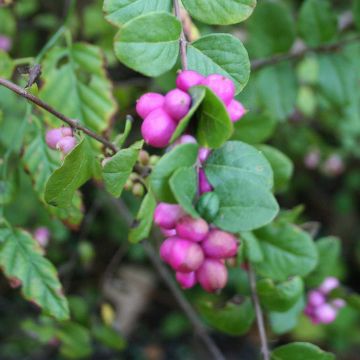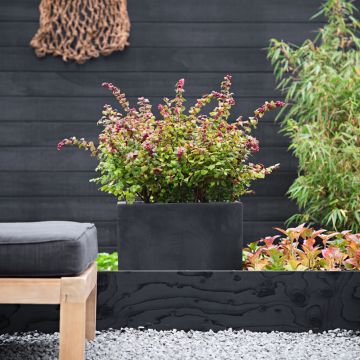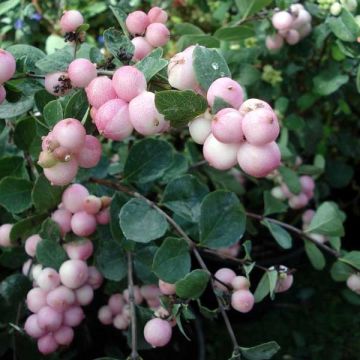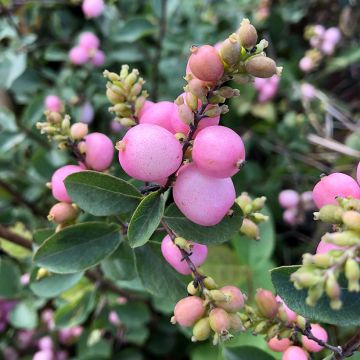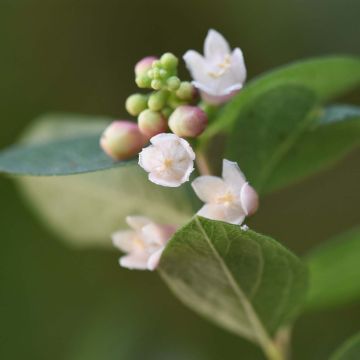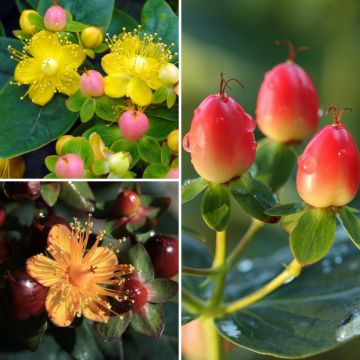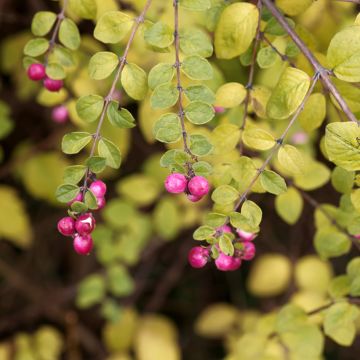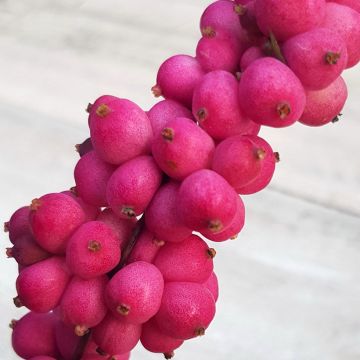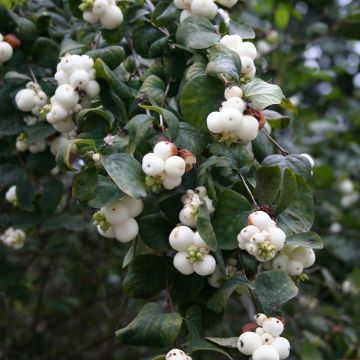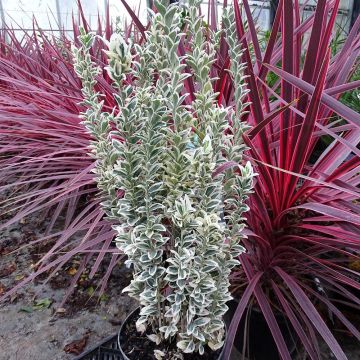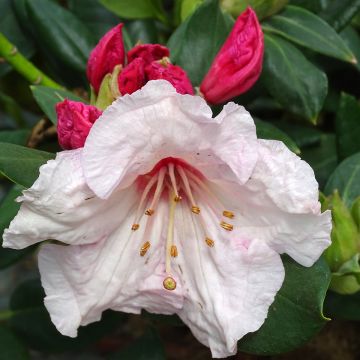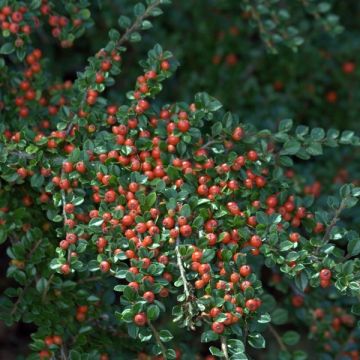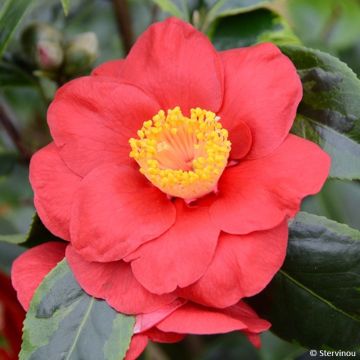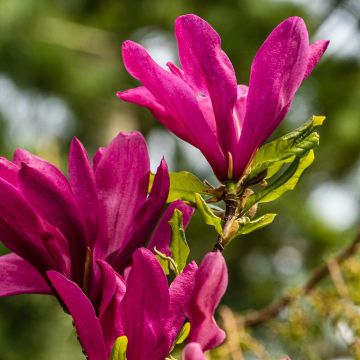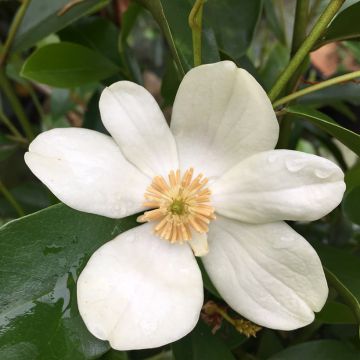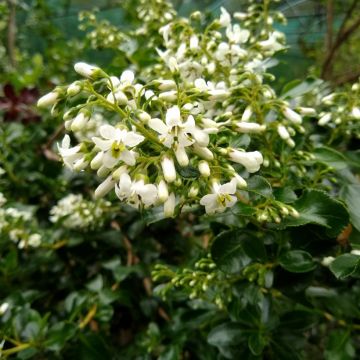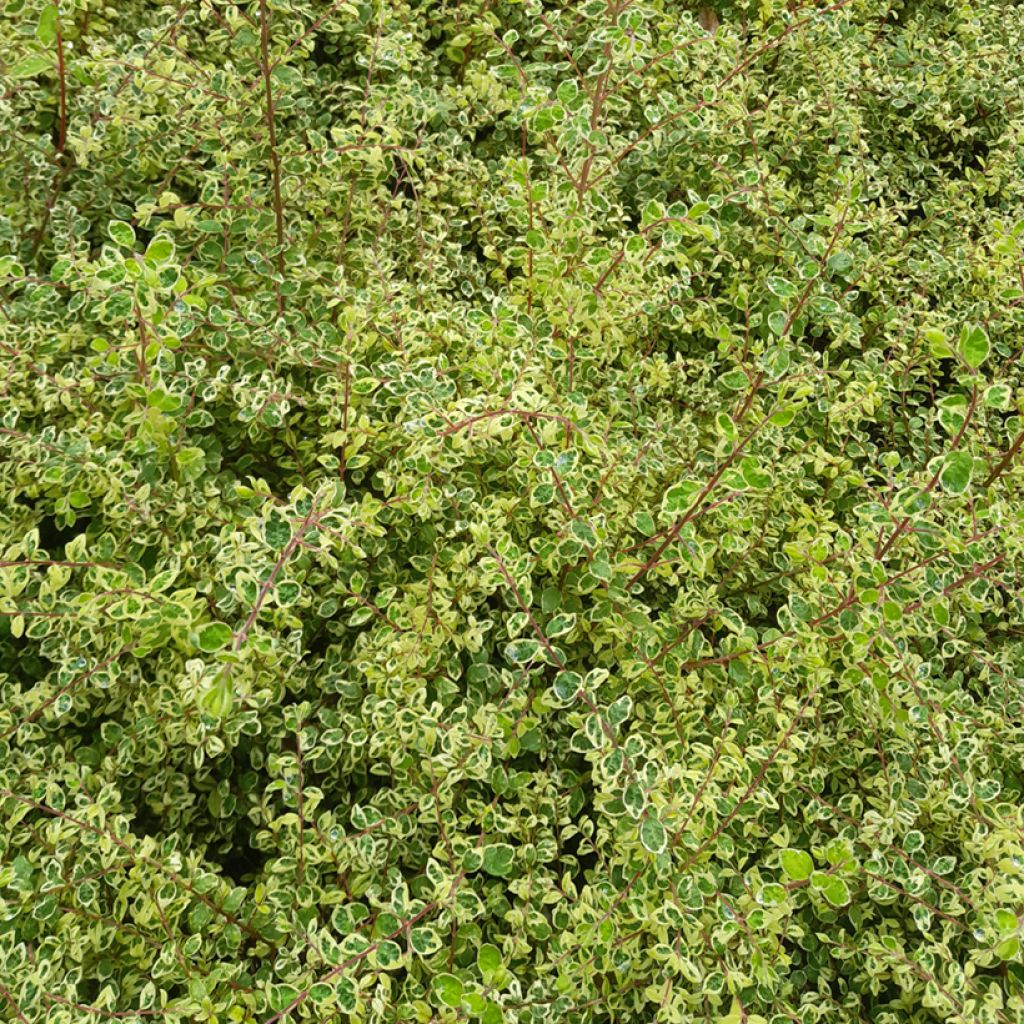

Symphorycarpos chenaultii Fiesta Berry
Symphorycarpos chenaultii Fiesta Berry
Symphorycarpos chenaultii ‘RANT02’ Fiesta Berry
Chenault Coralberry, Snowberry
This item cannot be shipped to the selected country
Delivery charge from €5.90
More information
Schedule delivery date,
and select date in basket
This plant carries a 24 months recovery warranty
More information
We guarantee the quality of our plants for a full growing cycle, and will replace at our expense any plant that fails to recover under normal climatic and planting conditions.
From €5.90 for pickup delivery and €6.90 for home delivery
Express home delivery from €8.90.
Does this plant fit my garden?
Set up your Plantfit profile →
Description
Symphoricarpos chenaultii 'Fiesta Berry' is a recent Dutch variety of Chenault's Snowberry, easily identifiable by its variegated foliage. The compact and bushy, shrub has a bright appearance that truly shines in the shaded areas it favours. Its relatively insignificant flowering gives way to small, decorative purple-red berries in autumn. Easy to cultivate in most ordinary soils, it thrives in both sun and shade, making it a virtually maintenance-free plant.
Snowberry is a member of the Caprifoliaceae family, like Honeysuckles (Lonicera) or Weigela. The genus Symphoricarpos, named by the famous French agronomist Henri Louis Duhamel du Monceau, comprises 15 species, all native to North America, except for one from China, named Symphoricarpos sinensis. It was an Orléans nurseryman, Chenault, who, by crossing the species S. orbiculatus and S. microphyllus around 1910, created a new hybrid, named S. x chenaultii. The bush forms a shrub 1.50 to 2 m tall, with supple and abundant branches, and small ovate leaves (1 to 2 cm).
'Fiesta Berry' is a horticultural variety obtained in the Netherlands by Ronny Antonissen and won a silver medal in 2022 at the professional nursery fair GrootGroenPlus during its market launch. It is the first variegated cultivar of Chenault's Snowberry. The shrub has a bushy habit, as wide as it is tall, with somewhat unruly branches that extend in all directions, giving it a slightly wild appearance. Of relatively rapid growth, it reaches about 1 m in all directions. The slender branches sometimes take on pinkish or mahogany brown tones, which beautifully complement the variegation of the leaves. Small, ovate, and oppositely arranged two by two on the branches, the lovely medium to dark green leaves are adorned with an irregular cream-white margin that creates a striking contrast. This variegated bush does well in full sun, unlike many others (the variegation, which corresponds to a lack of chlorophyll, makes the leaves sensitive), and also thrives very well in partial shade, even in full shade. In this situation, it is particularly valuable, as it brings light to somewhat dark areas of the garden. The flowering in late spring or early summer is discreet and relatively insignificant. It makes up for this by producing small ornamental purple-red berries from September to November, sometimes longer. This fruiting creates a superb contrast with the variegated foliage before it eventually falls to the ground as the Snowberry is deciduous.
Easy plants par excellence, Snowberries are favoured by beginners because they are decorative, require little maintenance and demonstrate great hardiness. 'Fiesta Berry' adds extra appeal with its stunning variegation that will bring brightness to a shaded bed. Plant it at the foot of a Viburnum tinus 'Purpureum', a Laurustinus whose young purple and bronze shoots in spring will create a very interesting colour combination, while its dark green foliage later on will perfectly highlight your Snowberry. Its white flowering in late winter is also attractive at a time still lacking in flowers. For an even stronger contrast, pair it with Physocarpus opulifolius 'Black Light', a small bushy shrub with almost black purple foliage, which in June-July is adorned with corymbs of small white flowers. To cover the ground in the foreground, choose from the range of Heucheras that will delight you with their colourful foliage as well as their graceful and airy flowerings.
Report an error about the product description
Plant habit
Flowering
Foliage
Botanical data
Symphorycarpos
chenaultii
‘RANT02’ Fiesta Berry
Caprifoliaceae
Chenault Coralberry, Snowberry
Cultivar or hybrid
Other Symphoricarpos
Planting and care
Symphoricarpos chenaultii 'Fiesta Berry' adapts to almost all exposures: it tolerates shade, but its foliage will be more colourful in partial shade or in full sun, which it handles well, unlike some other variegated plants. It is a very hardy bush that is easy to cultivate and suitable for any good garden soil. It even copes with dry soils riddled with roots found beneath large trees and at the foot of hedges. However, it prefers neutral, slightly calcareous or even slightly acidic areas, but without excess. It dislikes overly heavy, clayey soils that retain too much water. When planting, add a bit of potting soil to the existing soil and possibly some gravel at the bottom to promote drainage if necessary. You prune for balance at the end of winter. You may also remove the suckers to limit the bush's growth; this operation is not difficult.
Planting period
Intended location
Care
This item has not been reviewed yet - be the first to leave a review about it.
Shrubs for semi-shade
Haven't found what you were looking for?
Hardiness is the lowest winter temperature a plant can endure without suffering serious damage or even dying. However, hardiness is affected by location (a sheltered area, such as a patio), protection (winter cover) and soil type (hardiness is improved by well-drained soil).

Photo Sharing Terms & Conditions
In order to encourage gardeners to interact and share their experiences, Promesse de fleurs offers various media enabling content to be uploaded onto its Site - in particular via the ‘Photo sharing’ module.
The User agrees to refrain from:
- Posting any content that is illegal, prejudicial, insulting, racist, inciteful to hatred, revisionist, contrary to public decency, that infringes on privacy or on the privacy rights of third parties, in particular the publicity rights of persons and goods, intellectual property rights, or the right to privacy.
- Submitting content on behalf of a third party;
- Impersonate the identity of a third party and/or publish any personal information about a third party;
In general, the User undertakes to refrain from any unethical behaviour.
All Content (in particular text, comments, files, images, photos, videos, creative works, etc.), which may be subject to property or intellectual property rights, image or other private rights, shall remain the property of the User, subject to the limited rights granted by the terms of the licence granted by Promesse de fleurs as stated below. Users are at liberty to publish or not to publish such Content on the Site, notably via the ‘Photo Sharing’ facility, and accept that this Content shall be made public and freely accessible, notably on the Internet.
Users further acknowledge, undertake to have ,and guarantee that they hold all necessary rights and permissions to publish such material on the Site, in particular with regard to the legislation in force pertaining to any privacy, property, intellectual property, image, or contractual rights, or rights of any other nature. By publishing such Content on the Site, Users acknowledge accepting full liability as publishers of the Content within the meaning of the law, and grant Promesse de fleurs, free of charge, an inclusive, worldwide licence for the said Content for the entire duration of its publication, including all reproduction, representation, up/downloading, displaying, performing, transmission, and storage rights.
Users also grant permission for their name to be linked to the Content and accept that this link may not always be made available.
By engaging in posting material, Users consent to their Content becoming automatically accessible on the Internet, in particular on other sites and/or blogs and/or web pages of the Promesse de fleurs site, including in particular social pages and the Promesse de fleurs catalogue.
Users may secure the removal of entrusted content free of charge by issuing a simple request via our contact form.
The flowering period indicated on our website applies to countries and regions located in USDA zone 8 (France, the United Kingdom, Ireland, the Netherlands, etc.)
It will vary according to where you live:
- In zones 9 to 10 (Italy, Spain, Greece, etc.), flowering will occur about 2 to 4 weeks earlier.
- In zones 6 to 7 (Germany, Poland, Slovenia, and lower mountainous regions), flowering will be delayed by 2 to 3 weeks.
- In zone 5 (Central Europe, Scandinavia), blooming will be delayed by 3 to 5 weeks.
In temperate climates, pruning of spring-flowering shrubs (forsythia, spireas, etc.) should be done just after flowering.
Pruning of summer-flowering shrubs (Indian Lilac, Perovskia, etc.) can be done in winter or spring.
In cold regions as well as with frost-sensitive plants, avoid pruning too early when severe frosts may still occur.
The planting period indicated on our website applies to countries and regions located in USDA zone 8 (France, United Kingdom, Ireland, Netherlands).
It will vary according to where you live:
- In Mediterranean zones (Marseille, Madrid, Milan, etc.), autumn and winter are the best planting periods.
- In continental zones (Strasbourg, Munich, Vienna, etc.), delay planting by 2 to 3 weeks in spring and bring it forward by 2 to 4 weeks in autumn.
- In mountainous regions (the Alps, Pyrenees, Carpathians, etc.), it is best to plant in late spring (May-June) or late summer (August-September).
The harvesting period indicated on our website applies to countries and regions in USDA zone 8 (France, England, Ireland, the Netherlands).
In colder areas (Scandinavia, Poland, Austria...) fruit and vegetable harvests are likely to be delayed by 3-4 weeks.
In warmer areas (Italy, Spain, Greece, etc.), harvesting will probably take place earlier, depending on weather conditions.
The sowing periods indicated on our website apply to countries and regions within USDA Zone 8 (France, UK, Ireland, Netherlands).
In colder areas (Scandinavia, Poland, Austria...), delay any outdoor sowing by 3-4 weeks, or sow under glass.
In warmer climes (Italy, Spain, Greece, etc.), bring outdoor sowing forward by a few weeks.


































